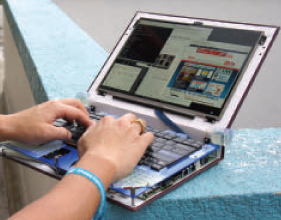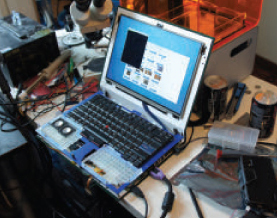SCRATCH-BUILDING YOUR OWN LAPTOP
Our open-source machines are made from off-the-shelf parts and see near-daily use.
Written by Bunnie Huang


I’m always behind a keyboard!

The first two prototypes are wrapped in red sheepskin leather, and green pigskin suede.

A DIY laptop parked in front of the Form 1 3D printer used to make its body panels.
![]() All the components should have a reasonably complete set of NDA-free documentation. This single requirement alone culled many choices.
All the components should have a reasonably complete set of NDA-free documentation. This single requirement alone culled many choices.
![]() Low cost is not an objective. I’m not looking to build a crippled platform based on some entry-level single-core SoC just so I can compete price-wise with the likes of Broadcom’s nonprofit Raspberry Pi platform.
Low cost is not an objective. I’m not looking to build a crippled platform based on some entry-level single-core SoC just so I can compete price-wise with the likes of Broadcom’s nonprofit Raspberry Pi platform.
![]() On the other hand, I can’t spec in unicorn hair, although I come close to that by making the outer case from genuine leather (I love that my laptop smells of leather when it runs). All the chips are ideally available off the shelf from distributors like Digi-Key and have at least a five-year production lifetime.
On the other hand, I can’t spec in unicorn hair, although I come close to that by making the outer case from genuine leather (I love that my laptop smells of leather when it runs). All the chips are ideally available off the shelf from distributors like Digi-Key and have at least a five-year production lifetime.
![]() Batteries are based on cheap and commonly available packs used in R/C hobby circles, enabling users to make the choice between battery-pack size, runtime, and mass. This makes it hard to answer the question of “what’s the battery life?” — it’s really up to you — although one planned scenario is the “Trans-Siberian railroad trek,” which is a weeklong trip with no power outlets.
Batteries are based on cheap and commonly available packs used in R/C hobby circles, enabling users to make the choice between battery-pack size, runtime, and mass. This makes it hard to answer the question of “what’s the battery life?” — it’s really up to you — although one planned scenario is the “Trans-Siberian railroad trek,” which is a weeklong trip with no power outlets.
![]() The display should also be user-configurable. The U.S. supply chain is weak when it comes to raw high-end LCD panels, and, in order to address the aforementioned Trans-Siberian scenario, we’d need the ability to drive a low-power display like a Pixel Qi but not make it a permanent choice. So, I designed the main board to work with a cheap LCD adapter board for maximum flexibility.
The display should also be user-configurable. The U.S. supply chain is weak when it comes to raw high-end LCD panels, and, in order to address the aforementioned Trans-Siberian scenario, we’d need the ability to drive a low-power display like a Pixel Qi but not make it a permanent choice. So, I designed the main board to work with a cheap LCD adapter board for maximum flexibility.
![]() No binary blobs should be required to boot and operate the system for the scenarios I care about. This one is a bit tricky, as it heavily limits the wi-fi card selection, I don’t use the GPU, and I rely on software-only decoders for video. But overall, the bet paid off; the laptop is still very usable in a binary-blob-free state. We prepared and gave a talk recently at 30C3 using only the laptops.
No binary blobs should be required to boot and operate the system for the scenarios I care about. This one is a bit tricky, as it heavily limits the wi-fi card selection, I don’t use the GPU, and I rely on software-only decoders for video. But overall, the bet paid off; the laptop is still very usable in a binary-blob-free state. We prepared and gave a talk recently at 30C3 using only the laptops.
![]() The physical design should be accessible — no need to remove a dozen screws just to pull off the keyboard. This design requires removing just two screws.
The physical design should be accessible — no need to remove a dozen screws just to pull off the keyboard. This design requires removing just two screws.
![]() The design doesn’t have to be particularly thin or light; I’d be happy if it was on par with the 3cm-thick ThinkPads or Inspirons I used back in the mid 2000’s.
The design doesn’t have to be particularly thin or light; I’d be happy if it was on par with the 3cm-thick ThinkPads or Inspirons I used back in the mid 2000’s.
![]() The machine also must be useful as a hardware hacking platform. This drives the rather unique inclusion of an FPGA into the mainboard.
The machine also must be useful as a hardware hacking platform. This drives the rather unique inclusion of an FPGA into the mainboard.
![]() The machine must be useful as a security hacking platform. This drives the other unusual inclusion of two Ethernet interfaces, a USB OTG port, and the addition of 256 MiB DDR3 RAM and a high-speed expansion connector off the FPGA.
The machine must be useful as a security hacking platform. This drives the other unusual inclusion of two Ethernet interfaces, a USB OTG port, and the addition of 256 MiB DDR3 RAM and a high-speed expansion connector off the FPGA.
![]() The machine must be able to build its own firmware from source. This drives certain minimum performance specs and mandates inclusion of a SATA interface for running off an SSD.
The machine must be able to build its own firmware from source. This drives certain minimum performance specs and mandates inclusion of a SATA interface for running off an SSD.
After more than a year and a half of hard work, I’m happy to say our machines are in a usable form. The motherboards are very reliable, and the display is a 13-inch, 2,560×1,700 (239 ppi) LED-backlit panel. The cases have an endoskeleton of 5052 and 7075 aluminum alloys, an exterior wrapping of genuine leather, an interior laminate of paper (I love books and papercraft), and cosmetic panels 3D-printed on a Form 1. The design is no ThinkPad X1 Carbon, but our machines have held together through a couple of rough international trips, and we use them almost every day.
I was surprised to find the laptop was well received by hackers, given its homebrew appearance, relatively meager specs, and high price. The positive response has encouraged us to plan a crowdfunding campaign around a substantially simplified case design (think “all-in-one PC” with a battery): That’s right, the final design will not look like these early, hand-built prototype cases. Follow @novenakosagi for updates on our progress!

